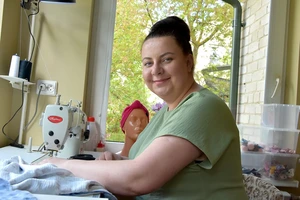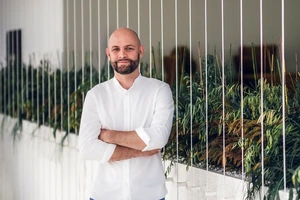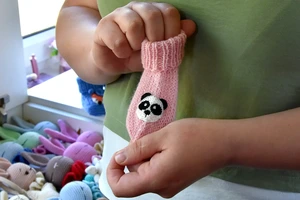According to Silvija, she enjoyed knitting. It was all new to her, but she was doing well. She started by knitting baby socks, and then, after watching YouTube videos, she continued to improve her skills and knitted a blanket for her daughter. After her daughter was born, Silvija managed to knit a vest and a hat for the colder months.
Now, Silvija has two daughters. Taking up a knitting habit has helped her cope with postnatal depression, and eventually it grew so much that a young businesswoman created a Facebook page where she presented her knitted items.
Domain name as a statement about Lithuanian identity
According to Silvija, her social media page quickly grew as mothers began ordering knitted baby socks. To stand out in a crowded market, she started adding Lithuanian inscriptions such as “My first socks” and “Hello, world!”, which attracted attention on Facebook. However, communicating with each customer individually became exhausting. “It was very time-consuming – everyone wanted something slightly different,” she recalls. That is when Silvija decided to create her own online store.
“When I finally registered a domain and opened the e-shop, everything became more organised. Orders, payments, and deliveries could be managed in one place,” she says. Yet, choosing the name was more than a practical step – it was a matter of identity. “My products create warmth that protects you from getting cold. I didn’t want an English name; I wanted something Lithuanian, subtle, and clear. The .lt top-level domain represents Lithuania, so nesušalk.lt (don’t get cold, in English) felt perfect. Its registration through domenai.lt was quick and convenient,” Silvija recalls.
Still, she faces challenges promoting the Lithuanian name online. “Social media platforms don’t allow diacritics – I’d love to use Nesušalk on Instagram, but it’s impossible. On Facebook, the domain sometimes appears as strange code or is even blocked as unsafe,” she explains.
For Silvija, nesušalk.lt is more than a website – it’s a statement about preserving the Lithuanian language and identity in the digital world.
The owners should register both names – with and without diacritics
Vaidotas Jakuška, Marketing and Communications Specialist at the Internet Service Centre DOMREG at Kaunas University of Technology (KTU), acknowledges that domain names with diacritics, such as in letters ą, č, ę, ė, į, š, ų, ū, ž of Lithuanian alphabet are rarely used due to inconveniences in displaying IDN (Internationalised Domain Names) domains on social networks, email, and other systems.





